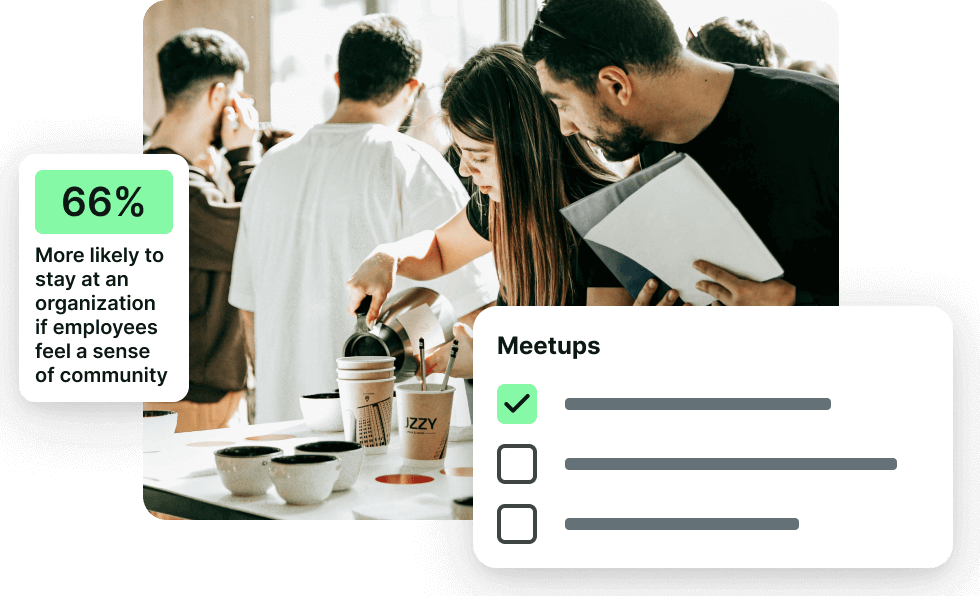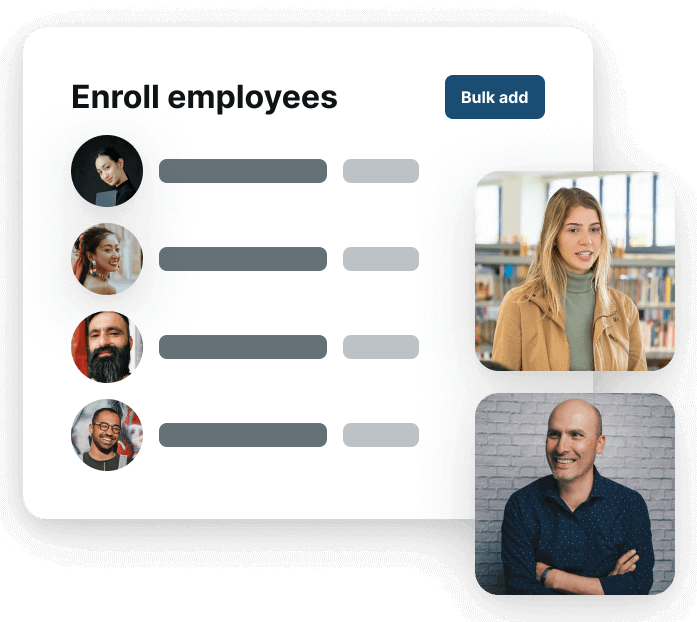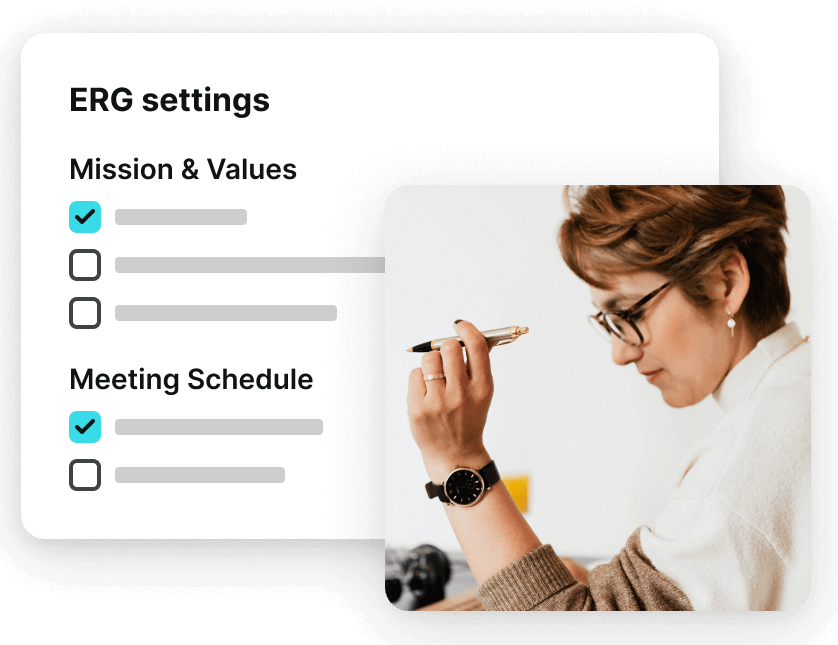Building Community
at Work
Between workplace malaise and the waffling ways of working many of us are meandering between, real community can feel lost in the crosshairs.

The Impact of Community at Work
One study found when people had a sense of community at work, they were:
58%
more likely to thrive at work
55%
more engaged
66%
more likely to stay with company
They also experienced less stress and were far more likely to thrive outside of work. Doubling down on this, Great Place to Work found employees who experience belonging in the workplace they are:
- 3X more likely to feel people look forward to coming to work
- 3X more likely to say their workplace culture is fun
These outcomes showcase the importance of community to employees, as well as organizations.
Start Building Employee Community
with Chronus Software
The Chronus platform offers a comprehensive solution for mentoring and ERGs to help organizations implement and manage effective mentoring programs.

Mentoring Software
With features designed to facilitate matching, tracking and reporting, Chronus mentoring software enables organizations to create meaningful connections and foster a supportive, engaged, and thriving community. Embed mentoring how-to resources into each step of your mentoring program to help participants make a connection that build community and strengthens workplace rapport.
A mentoring platform also enables organizations to track the outcomes of creating community through reports and dashboards, understanding the impact on employee satisfaction, engagement, performance and how employees work.

Connection Communities
For Connection Communities, Chronus’ platform simplifies the enrollment process for participants and creates consistency and standardization that increases employee participation. With the help of a platform, you can monitor the progress of employee communities while enabling events and driving communications.
Start your journey towards a stronger workplace community with Chronus today. Empower your employees, enhance employee engagement and drive success through the power of employee-driven development.
Ready to See Chronus Future-Ready Mentoring Platform Live?
What Makes a Strong Workplace Community?
A vigorous workplace community is built on the foundations of trust, mutual respect and shared values. It thrives when employees feel connected to each other, their leaders and the organization’s mission. In such communities, individuals collaborate and support one another frequently and fluidly. These interactions help to create a sense of belonging that transcends mere job functions.
By focusing on elements like social connections, supportive leadership, recognition, shared values, collaboration and open communication, organizations can build and sustain a strong workplace community where employees feel connected, engaged, and motivated to contribute to the collective success.
Why Focus on Building a Community at Work
Building a community at work is essential because it cultivates a sense of belonging among employees, which in turn encourages collaboration and teamwork. This will ultimately lead to a more cohesive and successful workplace environment. Below are four important reasons why organizations should prioritize building a workplace community.
Morale
A connected, positive workplace culture is a happy workplace. When employees build workplace communities, they experience higher job satisfaction and morale. They are more likely to enjoy their work, feel valued and stay motivated. High morale also leads to a more positive work environment, reducing stress and burnout. It can also improve general employee demeanor and temperament, making people easier to work and collaborate with.
Productivity
Community-driven workplaces see a boost in productivity. Employees who feel connected and supported are more likely to collaborate effectively, share knowledge, and work towards common goals. This collaborative spirit enhances efficiency and drives better employee engagement and outcomes. Additionally, a supportive community encourages open communication, leading to quicker resolution of issues and the free flow of innovative ideas. As a result, employees are not only more motivated but also more efficient.
Creativity
Innovation flourishes in a community-oriented workplace. When employees feel safe and supported, they are more likely to share ideas, take risks, and think outside the box. The diverse perspectives within a strong community can lead to groundbreaking solutions and continuous improvement. Community interaction can lead to more social exchange and resolutions that could solve customer problems, company culture tensions or even business development opportunities.
Retention
A strong sense of community is a powerful employee retention tool. Employees who feel connected to their colleagues and the organization are less likely to leave. Employees will stay longer at organizations where the connection to people is strong. Whether it is having a best friend at work or a core set of colleagues and peers to turn to, companies that focus on community can see longer tenures from employees, especially top talent. Building a supportive community reduces turnover, saving the organization significant recruitment and training costs.
Six Ways of Building a Community at Work
It doesn’t have to be hard or laborious, but it needs to be a priority. Below are six ways to build a strong community at work.
Create Shared Values and Mission
A shared sense of purpose unites employees and aligns their efforts toward common goals. When employees understand and believe in the company’s mission and values, they are more likely to feel connected to the workplace and its community members. These can be shared outings during Town Hall meetings, All-Hands events or team onsites. This shared vision and common language creates a sense of belonging and motivates employees to contribute to the organization’s success.
Activate Collaboration and Teamwork
A community thrives on collaboration and teamwork. Building rapport encourages employees to work together on projects, share knowledge and support each other’s efforts. This builds strong interpersonal relationships. Collaborative environments promote a sense of unity and collective achievement.
Showcase Recognition and Appreciation
Recognizing and appreciating employees’ contributions reinforces their sense of belonging and value within the community. Regular recognition programs, whether formal or informal, show employees that their efforts are noticed and appreciated.
Create Employee Communities
Connection Communities can be called a number of things such as affinity groups, business resource groups (BRGs), ERGs or people networks. These are all names for employee-led groups that provide support, enhance career development, and contribute to professional development in the workplace. These groups bring together individuals with common interests or backgrounds, fostering a sense of belonging and community. Communities can be powerful platforms for networking, mentorship, and advocacy, promoting inclusion and belonging within the organization.
Start a Mentoring Program
Mentoring is a cornerstone of community building. It creates connections between employees, facilitating knowledge transfer, skill development, and personal growth. Through mentoring, employees receive guidance, support, and encouragement, strengthening their ties to the organization. Through structured interactions with mentors, employees gain valuable insights into their strengths, weaknesses and areas for growth, enhancing their overall effectiveness and sense of community.
Spotlight Supportive Leadership
Leadership plays a critical role in shaping and maintaining a workplace community. Supportive leaders who actively engage with employees, provide guidance and demonstrate empathy create a nurturing environment. Leaders who embody the organization’s values and foster a culture of inclusivity set the tone for the entire community.
Discover Mentoring’s ROI With Our Employee Retention Calculator
Want to see how the power of mentoring can improve your business goals? Utilize our employee retention calculator to see how mentoring can retain employees and save you big money in the long-term.
Types of Mentoring for Building
a Workplace Community
Diversity Mentoring
Diversity mentoring pairs employees from different backgrounds and demographics to promote understanding, empathy, and inclusivity. It helps break down barriers, fosters cultural awareness, and builds cohesive and inclusive workplace communities. Diversity mentoring creates an environment of trust and support. It provides opportunities for employees who may have been left out of informal mentoring or sponsorship engagements previously, building a more inclusive workforce and developing the talent pipeline.
Mentoring Circles
Mentoring circles involve small groups of employees coming together to share experiences, challenges, and advice. This group mentoring approach provides multiple perspectives and fosters a collaborative learning environment, enhancing the sense of community. Since mentoring circles are generally run by employees, they require less organizational administration.
Group Mentoring
In group mentoring, one mentor works with several mentees simultaneously. This format encourages peer learning and support, creating a network of individuals who can share insights and experiences, further strengthening community bonds. This format also lends itself well for virtual mentoring. Bringing your meeting to a virtual arena can allow more accessibility for group members who may not make it to a physical meeting location for several reasons.
Conclusion
Building a community at work is not a one-time effort; it requires ongoing dedication and the right tools to foster genuine connections among employees. With Chronus’ mentoring and ERG software, organizations can systematically and effectively create an inclusive, engaging, and supportive workplace environment. By prioritizing community, you not only enhance employee morale and retention but also drive productivity and innovation. Begin your journey towards a more connected and thriving workplace with Chronus today. Empower your workforce and watch your company culture flourish.